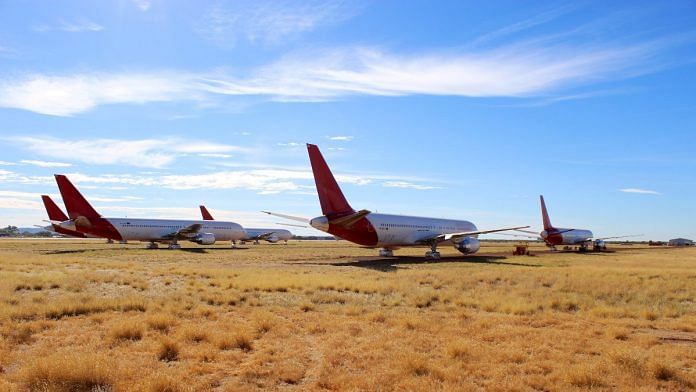Sydney: Aircraft engineer Dan Baker expected his career would let him see the world. And since starting as an apprentice aged 16 with British Airways in London, it’s taken him to Africa, the Caribbean, New Zealand and the Middle East, where he worked for Emirates.
Now he’s in a desert of a different sort — Australia’s vast red center. With the coronavirus pandemic upending global aviation and putting millions out of work, Baker has found an unlikely job in Alice Springs, storing and maintaining scores of grounded jumbo jets.
“I had to do a bit of looking up to see what life would be like,” Baker, 49, says of his new surrounds, a remote town of 25,000 better known as a jumping off point for famous sights like Uluru and the Olgas. “So far, it’s been great.”
The Asia Pacific Aircraft Storage facility (APAS) makes a strange and eerie sight, with the flat landscape punctuated by familiar tall tail fins against a brooding desert sky. More than 100 planes are stored at the purpose-built facility adjacent to the airport, which can keep jets maintained and ready to be brought back into service when needed. Despite spiraling Covid-19 case numbers in Europe and the U.S., some are returning to the skies.
Data from aviation analytics company Cirium show the number of aircraft making at least one flight per day in the Asia-Pacific region is almost back to pre-Covid levels. That’s largely thanks to recovering domestic markets in places like China, where the outbreak is more or less under control.
International routes, however, remain weak. The International Air Transport Association last month downgraded its traffic forecast for 2020 to reflect a weaker-than-expected recovery. The group, which represents some 290 airlines, now expects full-year traffic to be down 66% versus 2019, more than a previous estimate of a 63% decline. Tellingly, tail fins from Singapore Airlines Ltd. and Cathay Pacific Airways Ltd. — both carriers without a domestic market — are most commonly seen at the facility.
Cirium data also show the number of planes in storage around much of Asia declining. At Alice Springs, though, the numbers keep rising. Many Asian locations are too humid for long-term storage of aircraft, so planes that were parked there on the expectation of a quick return to the skies are now heading to Alice Springs, whose dry, desert air and cool nights make for near-perfect storage conditions.
APAS Managing Director Tom Vincent says the idea of a storage facility in Australia’s center had been around for a long time. But the former Deutsche Bank AG debt analyst was the first to act on it, raising A$5.5 million ($4 million) and clearing a slew of regulatory requirements to build it in 2013 before accepting his first plane a year later.
Vincent, 42, is planning for his facility to become the main southern hemisphere hub for long-term aircraft storage, even after the pandemic is over. He’s about to submit planning applications for a fourth expansion, including another huge fenced platform that will accommodate a further 60 wide-body jets, taking capacity to between 250 and 300 aircraft.
“It’s been intense,” Vincent says of 2020. He expects the number of planes parked at APAS to eventually settle at around 200. “It’s been an incredibly difficult time for the industry. Yes, there will be certain aircraft that go back into operation, hopefully sooner rather than later, but there’s still a huge pipeline of aircraft that are going to require parking and maintenance.”
Vincent has been on a necessary hiring spree, expanding to more than 80 employees, from locally hired administrative staff to highly skilled aircraft engineers like Baker.
Just two weeks into his new job, Baker’s days are spent supervising a three-stage induction process for each new plane, ranging from draining the engines of fluids to ensuring every last gap and crevice in the jet’s body is sealed from dust and insects.
One of the areas most at risk during long-term storage is the pitot-static system, a tiny opening at the front of every jet, and the static port, another cavity a little further along the side of the aircraft. Together, these two sensors provide airspeed data. “It’s fundamental to flight,” the New Zealand native explains from the packed dirt platform where the jets are prepared. “We get that covered up pretty quickly.”
It takes a team of a dozen people up to five days to induct a plane for storage. Two of those are spent entirely on taping and covering everything to protect the engines and systems, a process that can take between 40 and 50 rolls of tape.
While Vincent, an Australian who splits his time between Alice Springs and Brisbane, is reluctant to share the typical cost of storing a plane, he says every two weeks, APAS gets through a pallet of tape that costs almost A$50,000. Every plane has different requirements, depending on the manual. Airbus SE, for example, requires all passenger windows be covered and taped as well, while Boeing Co. does not.
Once inducted, sealed and towed to a parking bay, each plane is on a rolling system of seven, 30 and 90-day checks. During this time, bags of desiccant in the engine bays are examined, tires are rotated and brake systems are maintained. Storing a plane is certainly not simply a matter of parking it and walking away.
Vincent says aircrews can become quite nostalgic when they step off the plane for the last time.
“I meet most crews as they come off the aircraft,” he says. “They’re not sure when they’re going to see the aircraft again. Usually there’s photos. We like to say we’re going to look forward to when they come back to pick them up.”
Exactly when that might be remains an open question. For now, these planes sit silently in the Australian outback, a surreal monument to a different time. –Bloomberg
Also read: US put its ‘doomsday planes’ in air just before Trump’s Covid announcement



